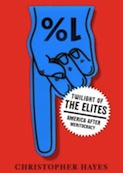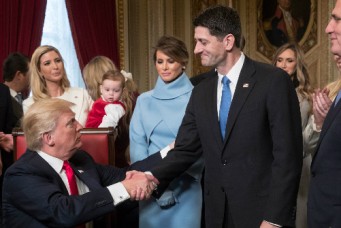Twilight of the Elites
The crisis of values in the land of opportunity.
Twilight of the Elites: America After Meritocracy. By Christopher Hayes. Crown, 2012. 304 pp.
Eighteen hours before Hurricane Katrina hit the coast of Louisiana on August 29, 2005, New Orleans Mayor Ray Nagin issued a mandatory evacuation of the city and warned that the hurricane was “a storm that most of us have long feared.” It was too little, too late. More than 300,000 residents didn’t manage to get out. Government preparations and emergency responses at local, state, and federal levels proved tragically inept. That fateful Monday morning, fifty-three federally constructed and maintained levees in the area failed, flooding 80 percent of New Orleans. By the time the waters receded, 1,400 people had died and citizen trust in government had been shattered. Katrina had become the costliest disaster in American history in more ways than one.
In the years since, the question has persisted: how could the government’s performance have been so awful? Yet similar breaches are everywhere. In Twilight of the Elites: America After Meritocracy, Christopher Hayes ties together a decade of American failures—the Katrina disaster, the Enron accounting fraud scandal, the subprime mortgage financial crisis, illegal performance enhancement steroids in professional sport, and sex abuse in the Catholic Church among others—with a thesis about class and government in America: today’s new elites are ruining the country.
Hayes, the editor-at-large of the Nation and a host on MSNBC, builds his argument on several interlocking conclusions about twentieth century America. After World War II, prosperity and unprecedented amounts of higher education among Americans coming of age in the 1960s opened up the selection process for which America would form its elite class during the latter half of the century. The new process was far more meritocratic than any in the past, when everything from race and gender to geography had posed barriers to upward mobility.
This meritocracy feels like the fairest social order that America has ever had. It gives everyone a chance to make it to the top. “Where the establishment emphasized humility, prudence, and lineage, the meritocracy celebrates ambition, achievement, brains, and self-betterment,” Hayes argues. Belief in meritocracy is arguably the most widely shared political belief in an increasingly diverse and divided country, accommodating the liberal desire for more inclusion and opportunity and the conservative desire for individualism. Yet, it turns out that the meritocracy isn’t working very well after all. As Hayes argues, it is corrupted by (among other things) greed, abundant opportunities and incentives to cheat, and the simple fact that the elites of government and business are so far out of touch with the public that they can’t possibly do what’s best for it.
America is not, nor has it ever been, a level playing field. Nowhere is this more visible than in the vastly disparate education system, where public schools are in a state of constant disrepair but children from rich families have a buffet of options to help them get ahead in school from day one: preschool, private school, and a booming test prep industry to name a few. In the meritocracy, the super-rich have tools at their disposal—including the ability to bend the law and ultimately insulate themselves from the law entirely—that help them both stay rich and get richer. Hayes cites the steroid scandals in Major League Baseball, for example. Players like Jose Canseco became superstar hitters by pumping themselves full of steroids, leading others to either follow suit or fall behind. Conseco’s salary jumped from $75,000 to $1.6 million, three times the league average, in just three years. Fan excitement over superstar performances enabled MLB to prosper and create a disincentive to crack down on illegal performance-enhancement practices. “The entire sport was caught up in a home run bubble,” Hayes says.
Taken together, these stories depict a country with a terrifying track record in the midst of a terrifying identity crisis. Hayes does a nice job of bouncing between moments of elite failure to pop psychology and research, to personal anecdotes—but building an argument this way is a little manipulative. Twilight of the Elites paints the last decade in its most extreme moments and leaves out the pieces that don’t fit (the Eurozone crisis, a struggling education system) and the bright spots (gay rights, health care reform). Failures that preceded the decade, such as Watergate or the recessions of the 1970s and 1980s, are almost invisible.
Twilight does provide a useful and pitch-perfect explanation of youth frustration with America and with President Barack Obama. Young progressives are more or less adrift in American politics today. Yet a few years ago, in 2008, America’s youth was fervently re-enfranchised by Obama’s run for the presidency and turned out in record numbers to elect him and his platform of “Change.” This excitement didn’t even last until the midterms. “Young Voters Say They Feel Abandoned,” read a headline in the New York Times in October 2010 that chronicled the “unexpected distance” that had emerged by that time between Barack Obama and the Millenials.
Many have said this falling out was inevitable; no President could cater to the sky-high expectations that young progressives had for Obama, especially when he inherited an economic crisis that would dominate much of his first term.
But there’s another way to interpret why young progressives were so disappointed: President Obama’s open and enthusiastic connection with America’s youth felt like a breach in the social distance that exists today between the public and the governing elite, but that feeling evaporated when as President, Obama failed to make young progressives feel any more heard by or represented in the White House. After the housing bubble burst and the ensuing financial crisis began, Obama pulled one baby boomer technocrat with a Wall Street background after another into his inner circle. White House Chief of Staff Rahm Emmanuel spent years in the Clinton administration and two and a half years as an investment banker at Wasserstein, Perella & Co., where he made more than $18 million, before entering the Obama administration. When Emmanuel left to run for mayor of Chicago, Obama replaced him with William Daley (Clinton administration, JP Morgan Chase), and Daley was later succeeded by Jack Lew (Clinton administration, Citigroup).
Young liberals may have been naïve to think that Obama would usher in a new and exciting era of progressive politics, especially after the financial crisis, but their resentments are still valid. The country is larger and more complex, the rich are richer, and the “have-nots” (namely the young and members of the working class) have to climb more rungs through the social stratosphere than in the past to be heard by those at the top. As a candidate, Barack Obama seemed to understand that distance and know how to bridge it, but as president he did not. In no sense was the 2012 presidential election, in which a millionaire with a JD from Harvard (Barack Obama) ran against a billionaire with a JD MBA from Harvard (Mitt Romney) a referendum on the elite.
Twilight of the Elites predicts that, as a country, America will likely continue fumbling forward until the system becomes so unsustainable that it will finally reach a crisis that it can’t pull itself out of. Or, as Hayes suggests, the 99 percent manages to convince the elite that the present state of affairs is so unsustainable and so far from the public interest that it needs to help chart a path towards a truly more equitable society.
Maggie Severns is a policy analyst for the New America Foundation’s Education Policy Program. She has written for the Washington Post, Washington Monthly, Slate, and Salon. On Twitter:@MaggieSeverns.





